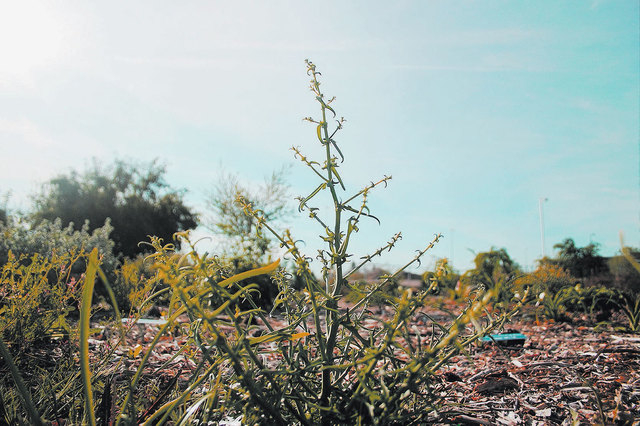Facing off against weeds requires strategy, patience
Much as gardeners might enjoy their yards, whether for lush greenery and flowers or for dramatic desert landscaping, not all plants that appear there are welcome. Weeds, those “plants out of place,” frequently arrive amid those that received tender nurturing from the time they were mere seedlings.
What’s worse, weeds too often outcompete them. They can crowd the desirable plants and shade them, drain their limited water resources, and extract the small amount of available soil nutrients. Some weeds even produce chemicals that inhibit other plants’ growth.
It would be easy to take care of weeds if they were ugly and obviously needed to be removed. Were that the case, who would have a weed problem? Unfortunately, that is far from true. Virtually any kind of plant can become a weed; a plant’s “weediness potential” does not depend on whether it is grassy or broad-leaved, if it flowers only once before it dies or if it is a long-lived perennial.
Whenever horticulturists introduce a new garden variety, their goal is to avoid bringing its damaging pests or pathogens along with it. That is a reasonable approach, unless that introduction leaps over its garden borders and invades other areas. With no predators or disease organisms to prevent it from overwhelming the environment, it can thrive.
Some of our most problematic weeds started as attractive garden plants. They were so successful they escaped into the wild, crowding out natives, and posing problems for indigenous plants and animal species.
Not all weeds had auspicious beginnings. Some arrived as contaminants in agricultural seed; some as small plant parts that drifted down a waterway and happened to find a safe haven; birds carried others to areas where they could take root.
However the unwelcome plants arrived, weed control is one of the most important activities that gardeners, landscapers and farmers perform. Keeping the weed population to a minimum is an effective way to conserve water and nutrients. There is also a certain satisfaction in keeping invaders out of the garden, whether they are pretty or not.
There are a few weeding methods that most people use. The general categories can be described as prevention, trying to stop weeds from getting established in the garden in the first place, and then physical, biological and chemical control.
If there is one phrase that covers all weed management efforts, it is “there’s no magic bullet.” Most of the time, no single method can control all weeds, and people find that they need to use two or three.
It is important to make sure that pots from the nursery are free of any weedy plants, but that is rarely enough. Even the most assiduous gardener will occasionally find that an unwelcome item has taken root. If only it were just one.
Weed infestations could be prevented by keeping out all incidental seeds in an ideal world, but that would mean eliminating significant aspects of the garden experience, such as fresh air (some weed seeds are airborne) and birds (that might drop seeds).
Covering garden soil with mulch can prevent many weed seeds from becoming established. This will not help much if weeds have been growing in place for some time.
Control methods need to be employed when prevention fails. The first is the traditional system: hand pulling, or using a hoe and a rake to chop and pull young weeds out of the ground. Over the past several decades, herbicides have become a popular way to rid a yard of weeds. These chemicals are easy to find but might even be too easy.
Although they are frequently labeled “weed killers,” that is a misnomer. These chemicals are designed to get rid of plants and make no distinction between desirable landscape plants and problematic weeds. Many plants have been damaged or worse because a chemical was used incorrectly. At Cooperative Extension, there is a publication that describes the kinds of damage herbicides can cause.
It is crucial to use the right herbicide. One that claims to kill weeds in lawns is designed not to kill grasses, but this product might kill other flowering plants nearby. It can be tempting to use something that promises to prevent weeds for months, even a year. While this might be terrific for sidewalks, it would definitely not suit an area where plants would be desirable. Something that states it will prevent weeds will not kill any that are established.
Fortunately, the containers of each of these products are labeled with all the information needed to use them successfully — not only which plants are affected, but also when and how to apply. The key is read the label — for the safety of plants, and the gardener who cares for them.
Angela O’Callaghan is the social horticulture specialist for University of Nevada Cooperative Extension. Contact ocallaghana@unce.unr.edu or 702-257-5581.

















